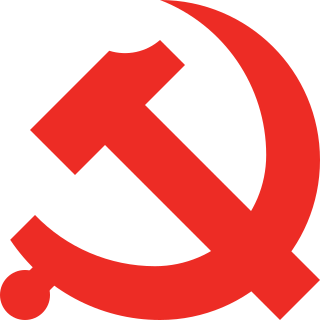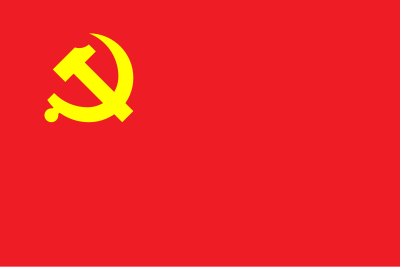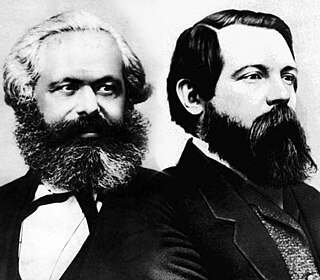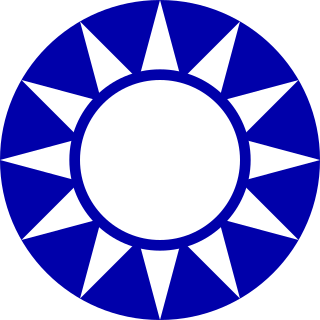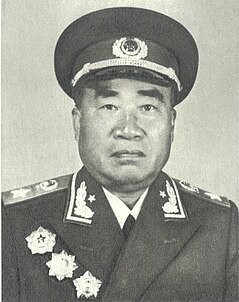
Deng Xiaoping was a Chinese politician who was the paramount leader of the People's Republic of China from 1978 until his retirement in 1989. After Chairman Mao Zedong's death in 1976, Deng led China through far-reaching market-economy reforms.

Maoism, known in China as Mao Zedong Thought, is a communist political theory derived from the teachings of the Chinese political leader Mao Zedong, whose followers are known as Maoists. Developed from the 1950s until the Deng Xiaoping reforms in the 1970s, it was widely applied as the guiding political and military ideology of the Communist Party of China and as theory guiding revolutionary movements around the world. A key difference between Maoism and other forms of Marxism–Leninism is that peasants should be the bulwark of the revolutionary energy, led by the working class in China.

Zhou Enlai was the first Premier of the People's Republic of China. Zhou was China's head of government, serving from October 1949 until his death in January 1976. Zhou served under Chairman Mao Zedong and was instrumental in the Communist Party's rise to power, and later in consolidating its control, forming foreign policy, and developing the Chinese economy.

Chen Duxiu was a Chinese revolutionary socialist, educator, philosopher, and author, who co-founded the Chinese Communist Party in 1921, serving from 1921 to 1927 as its first General Secretary. Chen was a leading figure in the Xinhai Revolution that overthrew the Qing dynasty and the May Fourth Movement for scientific and democratic developments in early Republic of China. Expelled from the Communist Party in 1929, he was for a time the leader of China's small Trotskyist movement.

The Sino-Soviet split (1956–1966) was the breaking of political relations between the People's Republic of China (PRC) and the Union of Soviet Socialist Republics (USSR), caused by doctrinal divergences that arose from their different interpretations and practical applications of Marxism–Leninism, as influenced by their respective geopolitics during the Cold War (1945–1991). In the late 1950s and the early 1960s, Sino-Soviet debates about the interpretation of Orthodox Marxism became specific disputes about the Soviet Union's policies of national de-Stalinization and international peaceful coexistence with the Western world. Against that political background, the international relations of the PRC featured official belligerence towards the West, and an initial, public rejection of the Soviet policy of peaceful coexistence between the Eastern bloc and the Western bloc, which Mao Zedong said was Marxist revisionism by the Russian communists.
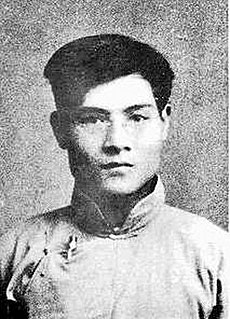
Zhang Guotao, or Chang Kuo-tao, was a founding member and important leader of the Chinese Communist Party (CCP) and bitter rival to Mao Zedong. During the 1920s he studied in the Soviet Union and became a key contact with the Comintern and organized the CCP labor movement in the United Front with the Guomindang. In 1931, after the Party had been driven from the cities, he established the E-Yu-Wan Soviet. When his armies were driven from the region, he joined the Long March but lost a contentious struggle for party leadership to Mao Zedong. Zhang's armies then took a different route from Mao's and were badly beaten by local forces in Gansu. When his depleted forces finally arrived to join Mao in Yan'an, Zhang continued his losing challenge to Mao, and left the party in 1938. Zhang eventually retired to Toronto, Canada, in 1968. He became a Christian shortly before his death in 1979. His memoirs provide valuable and vivid information on his life and party history.
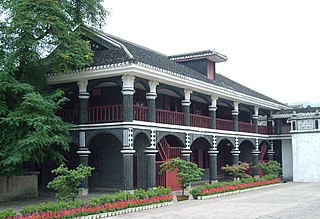
The Zunyi Conference was a meeting of the Communist Party of China (CPC) in January 1935 during the Long March. This meeting involved a power struggle between the leadership of Bo Gu and Otto Braun and the opposition led by Mao Zedong. The result was that Mao left the meeting in position to take over military command and become the leader of the Communist Party. The conference was completely unacknowledged until the 1950s and still no detailed descriptions were available until the fiftieth anniversary in 1985.
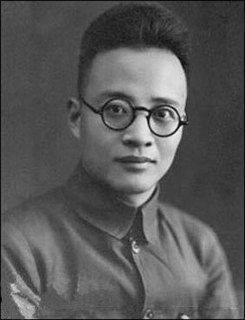
Qin Bangxian, better known as Bo Gu was a senior leader of the Chinese Communist Party and a member of the 28 Bolsheviks.

The Second United Front was the alliance between the Chinese Nationalist Party and Communist Party of China (CPC) to resist the Japanese invasion during the Second Sino-Japanese War, which suspended the Chinese Civil War from 1937 to 1941.
The Shanghai massacre of April 12, 1927, known commonly in China as the April 12 Purge or April 12 Incident, was the violent suppression of Communist Party of China (CPC) organizations in Shanghai by the military forces of Generalissimo Chiang Kai-shek and conservative factions in the Kuomintang. Following the incident, conservative KMT elements carried out a full-scale purge of Communists in all areas under their control, and even more violent suppression occurred in Guangzhou and Changsha. The purge led to an open split between left and right wing factions in the KMT, with Chiang Kai-shek establishing himself as the leader of the right wing faction based in Nanjing, in opposition to the original left-wing KMT government based in Wuhan led by Wang Jingwei.
In the history of political parties in China, the first major party in China was the Kuomintang (KMT), which moved to Taiwan in 1949. It was founded in Guangdong Province on August 25, 1912 from a union of several revolutionary groups. The Republic of China was founded by Kuomintang's leader Dr. Sun Yat-sen later that year. In 1921, the Communist Party of China (CPC) was founded by Chen Duxiu and Li Dazhao in Shanghai as a study society, and an informal political network.

The early revolutionary activity of Chinese revolutionary and politician Mao Zedong lasted for eight years, from 1919 to 1927. At the start of this period, Mao had moved to Peking, where he became a librarian's assistant at Peking University, simultaneously exploring both anarchism and Marxism and converting to the latter. Returning to Hunan in the context of the May Fourth Movement, Mao co-founded the Hunanese Student Association who began to publish politically radical literature. His publications earned Mao growing fame within the Chinese revolutionary movement, but invoked the anger of Hunanese Governor Zhang Jinghui, who repeatedly shut Mao's operation down.

Deng Zhongxia was an early member of the Communist Party of China and an important Marxist intellectual and labor movement leader. Having led many strikes and uprisings against Chiang Kai-shek's Kuomintang government, he became one of the most wanted CPC members by the Kuomintang. He was captured and executed in 1933.

The 1st National Congress of the Communist Party of China was held in Shanghai and Jiaxing between July 23 and August 2, 1921. The Congress established the Communist Party of China. It was succeeded by the 2nd National Congress of the Communist Party of China. The congress began in a shikumen building of the French Concession area of Shanghai. In early June 1921, Dutch national Henk Sneevliet, also known as Ma Lin, a representative of Comintern, arrived in Shanghai, and urged various Communist cells in the country to get together for a national-level meeting. Russian Comintern representative Nikolski also attended the meeting. At the time, there were 57 members of the Communist Party of China. Notably, the two founders of the party did not attend the congress: Chen Duxiu and Li Dazhao.

The Theory of National Struggle, or Ethnic Struggle, is one of Mao Zedong's political theories on the application of Marxism in China. This theory is also Mao Zedong's remedy to the "National Question" in Marxist theory. As a subset of the general philosophy of Mao Zedong Thought (Maoism), the theory of national struggle addresses the question of how classical Marxist-Leninist ideas of political economy should intersect with China's particular need for constructing a multi-ethnic national sovereignty without abandoning the universality of Marxism-Leninism. The gist of Mao's theory is that Chinese communists should treat the question of national and ethnic liberation in China as a subset of the larger socialist project of class conflict. In strategic terms, this means that the key to constructing a multiethnic Chinese nation-state is to mobilize and transform "backward" ethnic minorities into modern subjects of proletariat class consciousness under the leadership of the Chinese Communist Party (CCP).

The Wuhan nationalist government, also known as the Wuhan government, Wuhan regime, or Hankow government, was a left-wing nationalist government of China led first by Eugene Chen, and later by Wang Jingwei, that was based in Wuhan from 5 December 1926 to 21 September 1927. Following the capture of Wuhan during the Northern Expedition, the existing Kuomintang (KMT) government, which had been based in Guangzhou, moved there in December 1926. In April 1927, after National Revolutionary Army (NRA) commander-in-chief Chiang Kai-shek purged communists and leftists in the "Shanghai massacre", the Wuhan government split from Chiang in what is known as the "Nanjing–Wuhan split". Chiang subsequently formed his own government in Nanjing. While Chiang continued the Northern Expedition on his own, increasing tensions between communists and the KMT in the Wuhan government resulted in a new purge of communists from that government, and an eventual reconciliation with the Nanjing faction, after which the government moved to Nanjing.
